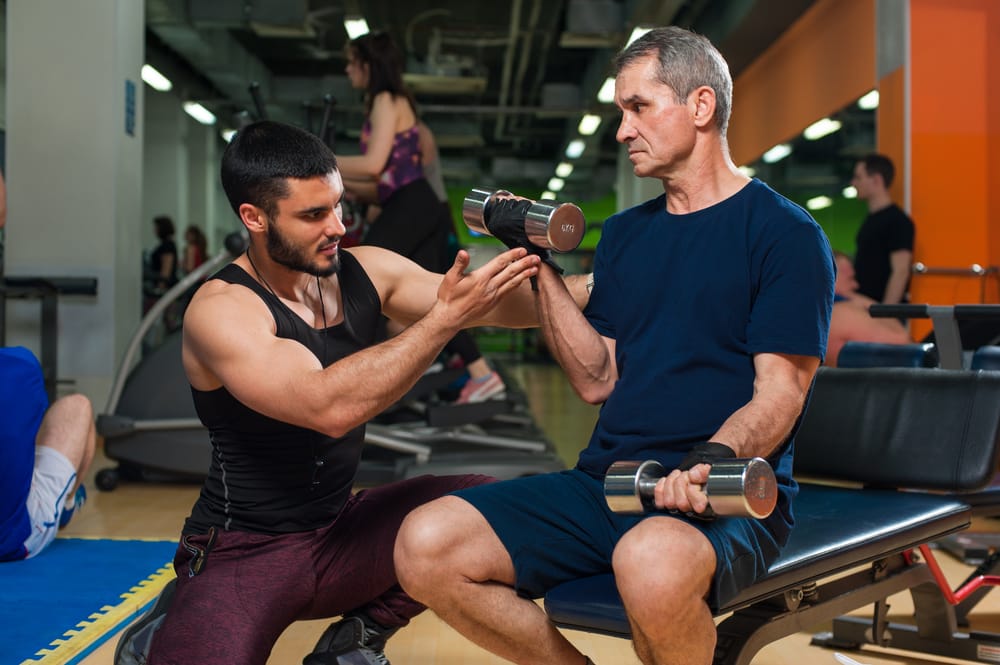When Bart and Homer Simpson swindled TV anchor Kent Brockman for some quick cash in a counterfeit cake operation, they knew they were on to something big. They form a father-and-son scam team, hoodwinking the locals in a series of con jobs for a nice bump in lifestyle. Once Grandpa Simpson catches on to their racket, he steers them to the mother load of liquidated life savings – Springfield Retirement Castle.
Seniors are always the easiest targets for con artists, whether it’s a long-distance love interest, a worldwide business opportunity, or a phony target letter threatening legal action. These operations also happen much closer to home.
It’s hard to accept that the fitness industry is just as guilty at grifting from America’s grandparents, but the scams are out there.
Special certs for old 'Pops'
To build up superficial credibility in the fitness industry, you need to learn the lingo with terms like “certs” and “special pops.” Eventually, the subject of senior fitness will come up.
The elder population has its special considerations, but as you are about to see, the means of training older adults are not much different than everybody else. What sets seniors apart from the general population (I really, really, really don’t like that term) is not how they train, but where they train.

Field-tested fraud
In pursuit of the ISSA specialist in senior fitness certification, I had to speak with a health professional and write a summary of their services.
A chiropractor in the area had a program for seniors. According to the receptionist, “It’s a lot like Curves, except that we take insurance.”
I found it suspicious that a program designed for pain-free living would keep a client’s feet off of the floor through the entire routine. Have you ever seen a trainer or physical therapist discourage able-bodied seniors from standing or walking? I knew I had to investigate.

After several phone calls asking for a consultation, they finally told me to stop calling. Either I was too pushy (impossible!) or perhaps they had something to hide. A short internet search told me everything that I needed to know.
The office was a franchise.
The chiropractor bought the rights and the equipment, and then the franchisers implemented the training routine. He didn’t even know how the system worked! Anybody can replicate the exercises, which are created more for liability and legal protection than for results, even if the franchisee knows nothing about muscle building or endurance training.
Would you, as a fitness trainer, work in a facility like that? Sadly, the aging population often prefers a controlled environment like the quack chiropractor’s office over a full-service health club. The good news is that you can attract the population that needs you most without any gimmicks or specialized marketing ploys.
What can we do about it?
How do you, as a full-service trainer who works with athletes and hard core fitness freaks, compete with a facility dedicated to senior citizen fitness?
The personal training profession has come a long way from the guy with the biggest muscles training the guy with the biggest wallet. Trainers help clients with all kinds of goals and objectives, meaning that we partner up with professionals in other fields.

Build your network
Fitness trailblazer Christine Conti leads the industry in promoting the next step in the evolution of fitness, the medical fitness specialist. She carries the message for trainers willing to step away from the sledgehammers and tractor tires and cater to clients who bring their health issues into the gym.
“The future of fitness is medical fitness,” said Conti. “Most of our clients are not coming to us because they need to look good in a bikini. The whole idea of fitness now is starting to cater to functionality as opposed to high impact ‘fill-in-the-blank’.”
The key in building the bridge from the doctor’s office to the gym floor, according to Christine, is to reach out directly to doctors and educate them of the capability of fitness trainers. “Doctors are not there to design exercise programs,” she said. “That’s where we as trainers come in. We have the ability to analyze body movements, kinetic chain, and balance.”

Christine emphasizes that most trainers are taught to work with healthy clients. However, the next wave of advanced certifications addresses health issues that our elder clients are likely to bring into the gym.
"The key words are chronic disease, comorbidity, lack of function, and loss of independence. One in four people have a chronic disease. What are we doing to serve those clients?"
The good news is that we are not tasked with curing people of their Alzheimer’s or Parkinson’s, only to guide them through the gym. “We’re working towards changing the dialogue,” Conti said. “If you really want to work and help this demographic, convincing doctors is the hardest problem to solve.” More good news is that people like Christine have created advanced certification courses for these conditions.
We as trainers already consult with nutritionists, chiropractors (only the good ones), physical therapists, and sometimes astrologers in order to understand the full range of helping professions employed by the client. Perhaps the most important member of the network is the hardest one to bring on board.
Semi-committed silver haired senior citizens set in their ways do not want to feel vulnerable or upstaged. They don’t want to hear you flaunt your knowledge. Doctors are no different. When you establish boundaries and show that you don’t encroach, you build the trust you need.
“There’s so much of a disconnect,” said Christine. “If trainers and doctors don’t get along, why is the doctor going to refer them? Their reputation is on the line.”
Christine, through her service Contifit, emphasizes reverse marketing, or letting your clients promote your services to their doctors in order to build your credibility. Just like the T in the FIT system is to transfer your lesson so that your audience can reteach it, you have to explain your training methods in a way that the client can explain it to a doctor.
Components of fitness
Whether you separate your clients into categories of general and special population, or if you simply train each client with a unique set of priorities, you can expect to train your clients above retirement age differently than you would train an athlete.

Put away the calipers and the sit and reach board, never mind the one-rep max on the hack squat, and don’t even think of pulling up the metronome app on your smartphone (actually, don’t even think about taking out the smartphone, but we cover that in another article).
Focus instead on coordination, balance, and my favorite word, kinesthesis. The ability to feel your body move is your sixth sense. It gives your body its deepest sense of self-awareness. This article is not a deep dive into proprioceptive exercises, so do your own homework on how to accomplish inner kinesthesis. For the record, I love the BoSU. I tell my clients that the word is Japanese for “half circle of life.” (For the real meaning of the word, go to www.bothsidesup.com)

VIP Hours
Once you stretch your fitness assessment beyond one rep max and counting pushups, the next key is your schedule. You know that certain people train at different times of the day. Chances are that the gym is quiet in the late mornings, when retirees have the time to see you. The mood is mellow, and you are probably feeling more laid back after the morning rush is over. Many trainers will tell you that the gym feels like a completely different place at different times of the day.
Just as Bart and Homer got busted trying to pull off their caper at the Springfield Retirement Castle, we can stop the fitness hucksters from swindling seniors of their money, time, and capacity to do great things on the gym floor. Build your network with the right professionals, train clients to stay limber and light on their feet, and we can give our senior clients the attention they deserve.

















